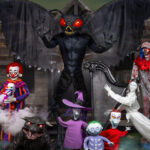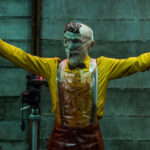Since my review of “The Call of Cthulhu: The Official Video Game”, I’ve played the game twice and have enough to give my final thoughts. The following will contain spoilers as I explain the overall main plot as it may be confusing to those who have played the game and have questions, but at the end (My final thoughts) are spoiler free if you wish to skip down to that.
SPOILERS AHEAD!

Some of the information I’ll skip over as it’s been mentioned in my review. On the island of Darkwater, the locals are obsessed with a legendary story about the “Miraculous Catch”, the whaling community was starving as the whales seemed to have vanished from the waters surrounding the island in the 1840’s. One whaling ship came back missing half its crew that was lost during the fight to catch this gigantic “Whale” that fed the entire island.
Three of the island’s inhabitants, Captain Fitzroy, Dr. Fuller, and Jack Hawkins are the sons of sailors who survived the “Miraculous Catch”, it’s later reviled that the three are in fact the SAME sailors as it turns out the whale that was captured was really an otherworldly creature they called “Leviathan” whose flesh changed those who ate it, and since plagued them with nightmare visions and spawned the cult of Cthulhu as they keep hearing his “call” and Sarah Hawkins is the cult’s oracle as she paints her visions.

Leviathan’s capture was planned by the creature to ensure setting in motion for the “call” to be answered by the “truth seeker”. Meanwhile, Leviathan itself is still alive and has its meat and blubber harvested for food, oil, and Dr. Fuller’s experiments.
Cave paintings and books indicated that Native Americans once lived on the island but have vanished in which the cave paintings have hinted that the Natives all sacrificed themselves to the Leviathan. It becomes clear that the island of Darkwater is, in fact, R’lyeh, Cthulhu’s home and depending on the player’s choice at the end can summon Cthulhu.

Throughout the game, there are many references to some of Lovecraft’s works and I’m sure other references to the works of other authors who have made their marks in the Cthulhu Mythos. From playing the game twice I’ve been able to pick out some references I’ve missed playing the first time through.
At one point in the game you see fossilized remains of little Cthulhu looking creatures in rock, this was a main plot point in the short story “At the Mountains of Madness” where the fossils of “Star Spawns” (Cthulhu’s Children) were found. The Hawkins’ mansion itself referenced two stories, the first being “The Strange High House in the Mist” where a house is located high up a craggy mountainside overlooking the ocean, very much like the Hawkins’ mansion. The second reference is “The Rats in the Walls” but unlike the story, you actually see a large number of rats running across the floor at times as well as hearing strange noises in the walls.

In a portion of the story, as you play as a doctor, you examine a patient who is showing signs of mutating into an aquatic life form, very much like “The Shadow over Innsmouth” where some citizens of the town have turned or are currently turning into fish/frog-like creatures. Speaking of Doctors, Dr. Fuller is obsessed with human experimentation involving a serum of his that has the ability to bring people back to life, a definite nod to “Herbert West- Reanimator” in which the title character was obsessively perfecting a chemical that re-animates corpses.
Jack Hawkins desperate search and failed attempt to steal the notorious Necronomicon mirrors that of Wilbur Whateley from “The Dunwich Horror” who was a chimera-like creature and Jack was partially transformed into an octopus-like creature. Another character shares similar traits with another from the same book, Drake the bookstore owner and occultist and is a lot like the characters Henry Armitage from “The Dunwich Horror” and Marnius Willett in “The case of Charles Dexter Ward”. All three used incantations to defeat supernatural foes and share the character traits of being arrogant with a feeling of self-importance.
The overall core of the story surrounds Sarah Hawkins’ painting of “The Shambler” in which the subject of the painting is a real thing that Sarah has seen with her own eyes, this is a lot like “Pickman’s Model” where an artist famous for his disturbing paintings of creatures is discovered to have these creatures living in his basement. Finally, keeping with art, in the game you go to inspect Hawkins’ painting.

In the art gallery, there are many Egyptian artifacts as well as a creepy looking sphinx. These are clear references to the reoccurring being known as Nyarlathotep who first appeared in Lovecraft’s “Nyarlathotep” and again in the form of a poem in“Fungi from Yuggoth”. He’s a shapeshifter and appeared in “The Dreams in the Witch House” and “The Haunter in the Dark”, one of his forms was that of a Sphinx with piercing eyes.
END OF SPOILERS

“The Call of Cthulhu: The Official Video Game” is a treasure trove of Lovecraftian goodness. The multiple choices you have from start to finish allow you to determine the path for Edward Pierce takes as well as determining the fate of others. The more unnatural things Pierce sees, the more sanity he loses, the higher your “hidden clues” ability are up, the more secrets you can uncover. Replayability for this game is high especially for Lovecraft fans. My final thought on the game, it’s worth the mind-numbing questions, it’s worth the confusion, and it’s worth the nightmares.
If you are interested in reading any of the works mentioned in this article, you can read them HERE.
Exclusives and Sneak Peeks: “Welcome to Derry” Heads to San Diego Comic-Con
Get ready to return to the nightmare! The chilling new poster for "IT: Welcome to Derry" is out ahead of San Diego...











